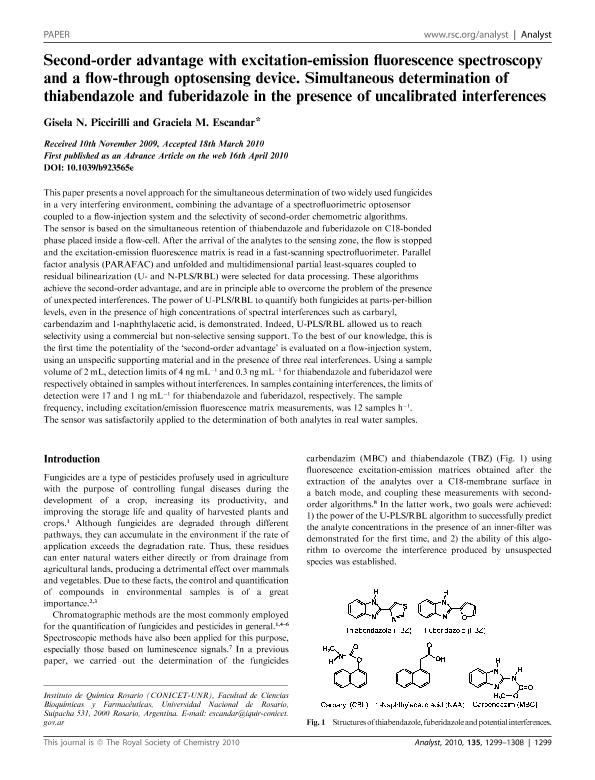Artículo
Second-order advantage with excitation-emission fluorescence spectroscopy and a flow-through optosensing device: Simultaneous determination of thiabendazole and fuberidazole in the presence of uncalibrated interferences
Fecha de publicación:
04/2010
Editorial:
Royal Society of Chemistry
Revista:
Analyst
ISSN:
0003-2654
Idioma:
Inglés
Tipo de recurso:
Artículo publicado
Clasificación temática:
Resumen
This paper presents a novel approach for the simultaneous determination of two widely used fungicides in a very interfering environment, combining the advantage of a spectrofluorimetric optosensor coupled to a flow-injection system and the selectivity of second-order chemometric algorithms. The sensor is based on the simultaneous retention of thiabendazole and fuberidazole on C18-bonded phase placed inside a flow-cell. After the arrival of the analytes to the sensing zone, the flow is stopped and the excitation-emission fluorescence matrix is read in a fast-scanning spectrofluorimeter. Parallel factor analysis (PARAFAC) and unfolded and multidimensional partial least-squares coupled to residual bilinearization (U- and N-PLS/RBL) were selected for data processing. These algorithms achieve the second-order advantage, and are in principle able to overcome the problem of the presence of unexpected interferences. The power of U-PLS/RBL to quantify both fungicides at parts-per-billion levels, even in the presence of high concentrations of spectral interferences such as carbaryl, carbendazim and 1-naphthylacetic acid, is demonstrated. Indeed, U-PLS/RBL allowed us to reach selectivity using a commercial but non-selective sensing support. To the best of our knowledge, this is the first time the potentiality of the 'second-order advantage' is evaluated on a flow-injection system, using an unspecific supporting material and in the presence of three real interferences. Using a sample volume of 2 mL, detection limits of 4 ng mL -1 and 0.3 ng mL-1 for thiabendazole and fuberidazol were respectively obtained in samples without interferences. In samples containing interferences, the limits of detection were 17 and 1 ng mL-1 for thiabendazole and fuberidazol, respectively. The sample frequency, including excitation/emission fluorescence matrix measurements, was 12 samples h -1. The sensor was satisfactorily applied to the determination of both analytes in real water samples.
Palabras clave:
SECOND-ORDER
,
FLUORESCENCE
Archivos asociados
Licencia
Identificadores
Colecciones
Articulos(IQUIR)
Articulos de INST.DE QUIMICA ROSARIO
Articulos de INST.DE QUIMICA ROSARIO
Citación
Piccirilli, Gisela Noemi; Escandar, Graciela Monica; Second-order advantage with excitation-emission fluorescence spectroscopy and a flow-through optosensing device: Simultaneous determination of thiabendazole and fuberidazole in the presence of uncalibrated interferences; Royal Society of Chemistry; Analyst; 135; 6; 4-2010; 1299-1308
Compartir
Altmétricas




